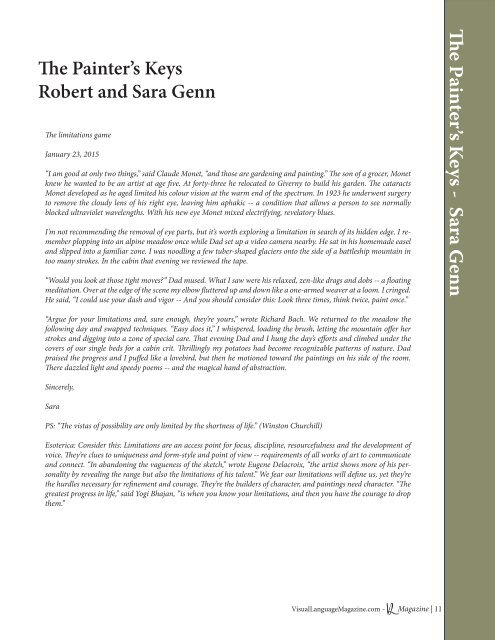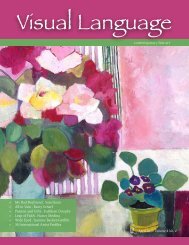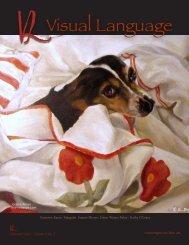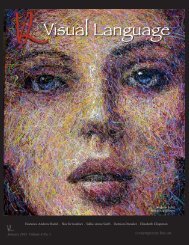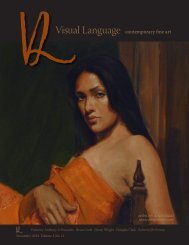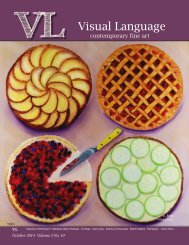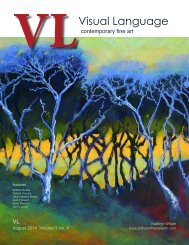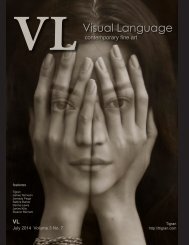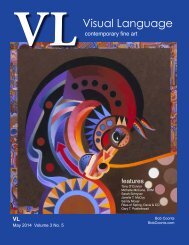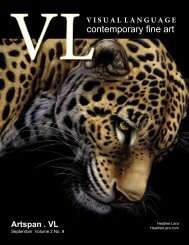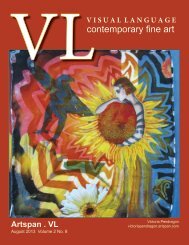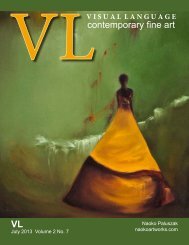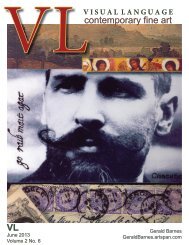Visual Language Magazine Contemporary Fine ARt Vol 4 No 3 March 2015
Visual Language Magazine Contemporary Fine Art Vol 4 No 3 March 2015 features American Artist Robert Duncan, Mary Jane Q Cross, Canadian Artist David Francis, Barbara Rudolph, and South African Artist Sabine Barbar. This issues features figurative, Landscape and Realism. Visual Language is the common connection around the world for art expressed through every media and process. The artists connect through their creativity to the viewers by both their process as well as their final piece. No interpreters are necessary because Visual Language Magazine crosses all boundaries.
Visual Language Magazine Contemporary Fine Art Vol 4 No 3 March 2015 features American Artist Robert Duncan, Mary Jane Q Cross, Canadian Artist David Francis, Barbara Rudolph, and South African Artist Sabine Barbar. This issues features figurative, Landscape and Realism.
Visual Language is the common connection around the world for art expressed through every media and process. The artists connect through their creativity to the viewers by both their process as well as their final piece. No interpreters are necessary because Visual Language Magazine crosses all boundaries.
Create successful ePaper yourself
Turn your PDF publications into a flip-book with our unique Google optimized e-Paper software.
The Painter’s Keys<br />
Robert and Sara Genn<br />
The limitations game<br />
January 23, <strong>2015</strong><br />
“I am good at only two things,” said Claude Monet, “and those are gardening and painting.” The son of a grocer, Monet<br />
knew he wanted to be an artist at age five. At forty-three he relocated to Giverny to build his garden. The cataracts<br />
Monet developed as he aged limited his colour vision at the warm end of the spectrum. In 1923 he underwent surgery<br />
to remove the cloudy lens of his right eye, leaving him aphakic -- a condition that allows a person to see normally<br />
blocked ultraviolet wavelengths. With his new eye Monet mixed electrifying, revelatory blues.<br />
I’m not recommending the removal of eye parts, but it’s worth exploring a limitation in search of its hidden edge. I remember<br />
plopping into an alpine meadow once while Dad set up a video camera nearby. He sat in his homemade easel<br />
and slipped into a familiar zone. I was noodling a few tuber-shaped glaciers onto the side of a battleship mountain in<br />
too many strokes. In the cabin that evening we reviewed the tape.<br />
“Would you look at those tight moves” Dad mused. What I saw were his relaxed, zen-like drags and dobs -- a floating<br />
meditation. Over at the edge of the scene my elbow fluttered up and down like a one-armed weaver at a loom. I cringed.<br />
He said, “I could use your dash and vigor -- And you should consider this: Look three times, think twice, paint once.”<br />
The Painter’s Keys - Sara Genn<br />
“Argue for your limitations and, sure enough, they’re yours,” wrote Richard Bach. We returned to the meadow the<br />
following day and swapped techniques. “Easy does it,” I whispered, loading the brush, letting the mountain offer her<br />
strokes and digging into a zone of special care. That evening Dad and I hung the day’s efforts and climbed under the<br />
covers of our single beds for a cabin crit. Thrillingly my potatoes had become recognizable patterns of nature. Dad<br />
praised the progress and I puffed like a lovebird, but then he motioned toward the paintings on his side of the room.<br />
There dazzled light and speedy poems -- and the magical hand of abstraction.<br />
Sincerely,<br />
Sara<br />
PS: “The vistas of possibility are only limited by the shortness of life.” (Winston Churchill)<br />
Esoterica: Consider this: Limitations are an access point for focus, discipline, resourcefulness and the development of<br />
voice. They’re clues to uniqueness and form-style and point of view -- requirements of all works of art to communicate<br />
and connect. “In abandoning the vagueness of the sketch,” wrote Eugene Delacroix, “the artist shows more of his personality<br />
by revealing the range but also the limitations of his talent.” We fear our limitations will define us, yet they’re<br />
the hurdles necessary for refinement and courage. They’re the builders of character, and paintings need character. “The<br />
greatest progress in life,” said Yogi Bhajan, “is when you know your limitations, and then you have the courage to drop<br />
them.”<br />
<strong>Visual</strong><strong>Language</strong><strong>Magazine</strong>.com - VL <strong>Magazine</strong> | 11


